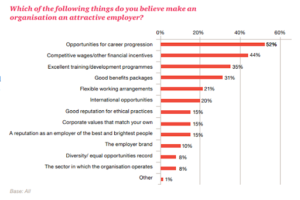Internal mobility The Complete Guide to Internal Mobility — Paddle (paddlehr.com)refers to the movement of existing employees across different departments or roles within the organization. These may be “permanent” roles such as an employee who moves laterally from an Accounting position into a Finance position or an employee who is promoted from Accounting Supervisor to Accounting Manager.
An internal mobility program can ensure employee retention, leadership development and produces well-rounded employees who truly understand the various aspects of the business. It also reduces cost, time, and effort in hiring outside talent.
The successful cross-functional movement of employees starts with a well-thought-out program and a receptive work culture. In order to grow, leadership and HR must develop a culture where employees have an opportunity to learn new skills.
https://harver.com/wp-content/uploads/2020/05/Attractive-Employers-According-to-Millenials.png
In PwC’s most recent Millennials at Work survey, they found that the #1 most attractive employer attribute was the possibility of career progression.
Talent Profiles
Internal mobility is only truly possible if you know what each employee is capable of and the skills that they already possess. Auditing each team member, preferably during the hiring stage, and then again annually, will enable you to track the skills each employee has, what skills are needed and what gaps remain. Managers should use Talent Profiles to assess career opportunities for each person on their team.
Career Paths
Develop learner pathways that employees can reference and develop self-directed training programs that will assist employees in transitioning into new roles or to learning new skills
Succession Planning
Succession plans are necessary so you have a clear idea of what will happen if an employee leaves their position. Who in the organization could be tapped for a promotion?
As Harvard Business Review Succession Planning: What the Research Says (hbr.org) bleakly highlights, all CEOs will inevitably leave office, yet research shows most organizations are ill-prepared to replace them. However, a CIPHR study found that although 92% of companies admitted it was a risk to not have a succession plan in place, only 25% felt they had the right candidates to fill vacant positions. To fill the void, you can look within your current talent pool, or hire externally.
According to PaddleHR, The Complete Guide to Internal Mobility — Paddle (paddlehr.com) 66% of job seekers look at the current company before looking elsewhere for a job. Now is the time to stem the tide of the Great Resignation The Great Resignation: Why people are quitting their jobs (cnbc.com)and ensure you are offering your employees a reason to stay!

